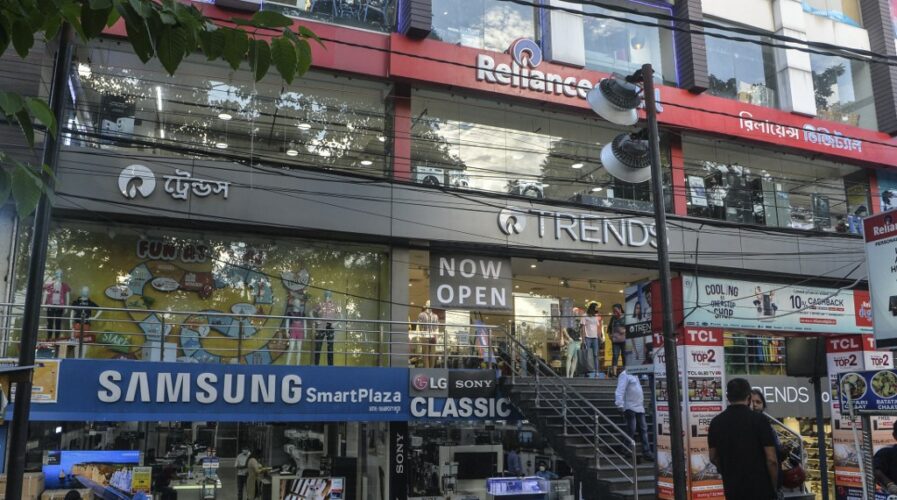
The landscape of shopping in India has changed, and while retail is not dead, retailers need to keep up with trends. (Photo by Diptendu DUTTA / AFP)
Shopping in India is changing — here’s how
The Covid-19 pandemic has dramatically transformed the way industries operate, especially in traditionally physical sectors such as retail. The landscape of shopping in India has changed, and while retail is not dead, retailers need to keep up with trends.
As more Indians moved online due to movement restrictions coupled with increased internet penetration and smartphone usage, e-commerce took off.
Consumers purchased anything from fast-moving consumer goods (FMCG) to fashion, and more. In the last quarter of 2020 alone, e-Commerce purchase volumes increased 36%, with the largest segment being in personal care, beauty and wellness.
Retailers, seeing this surge in demand for online shopping pivoted their sales and marketing strategies, with omnichannel retailers seeing a greater advantage over their peers.
Today, many online shoppers in India know what they want — convenience, variety, value for money, digital or contactless payment options, and quick delivery. Here are some retail trends that are expected to stay, even in a post-pandemic India.
Same-day delivery
Online shopping is hugely convenient for shoppers as they do not have to leave the house. Businesses, especially those that provide same-day, and especially one-hour deliveries, tend to be very popular.
This is immensely attractive to customers, as high-demand essentials such as groceries and pharmaceuticals could be delivered very rapidly.
To meet these consumer needs, retailers scaled their order fulfillment processes by repurposing closed stores as local fulfillment centers. Customers would expect the same convenience and experience, so it is very likely that same-day delivery will continue to remain the norm.
Real-time payments with UPI
India is the country most in favor of a cashless society as 79% of Indians believe going cashless would have a positive impact on their country. India’s largest real-time payment network, Unified Payments Interface (UPI), promises a safe, instantaneous, and contactless form of payment.
UPI is an instant payment system that allows customers to instantly transfer money between any two parties bank accounts. As customers increasingly shy away from cash or card payments, UPI will naturally take over as the preferred form of payment, whether for online or offline purchases. Payment for shopping in India is heading towards contactless, digital payments, real-time payment solutions such as UPI will be here for the long haul.
Augmented Reality shopping
Trying-before-buying poses health risks for customers, so the next best thing would be to allow customers to virtually try products on before deciding on purchasing them. Some retailers are experimenting with using Augmented Reality (AR), which can be used for any products that can be worn or carried on the body, such as clothing, accessories, or cosmetics.
Not only would this be attractive for offline shoppers, but it is also highly convenient for online shoppers as well, especially since it can be provided as a service on websites or mobile apps as long as there’s an internet connection.
Personalized shopping experiences
In this rapidly digitalizing world, customers are more amenable to purchasing something when they receive highly personalized content.
Customers expect brands and companies to know their likes, preferences, and interests, and to have them reflected in marketing communications and the products or services they are recommended.
Data is power, and online retailers should know that. Good data will help with analytics to give businesses better insights on decision making, but it can also go towards ensuring a better customer experience.
Mobile marketing
It’s not just in India – everywhere, around the world, people are using their mobile devices for longer hours every day. Most digital content consumed is on mobile devices, be it reading material, social media, video, or music.
Content consumption also affects the way consumers consider and make decisions on purchases. As such, content pushed out online should be mobile optimized — including how ads are served, and how seamless the customer journey will be from the ad to the shopping cart.
Higher demand for e-commerce in smaller towns
Small towns have shown the growth potential for e-commerce, but not all consumers here are naturally inclined to place orders online.
Retailers should develop strategies that work for smaller markets, such as creating jobs, setting up warehouses, last-mile connectivity, and availability of vernacular content. In physical stores, brands can install large format screens to offer better product views and experiences.
Also, the availability of in-store digital payment modes will ensure hassle-free ordering and payments for customers facing internet and connectivity issues.
READ MORE
- Ethical AI: The renewed importance of safeguarding data and customer privacy in Generative AI applications
- How Japan balances AI-driven opportunities with cybersecurity needs
- Deploying SASE: Benchmarking your approach
- Insurance everywhere all at once: the digital transformation of the APAC insurance industry
- Google parent Alphabet eyes HubSpot: A potential acquisition shaping the future of CRM
